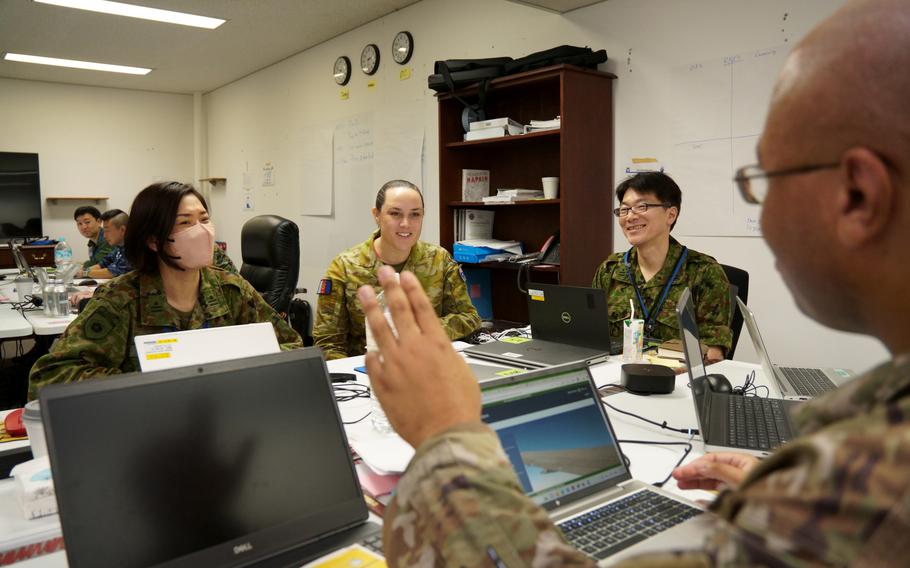
U.S., Japanese and Australian troops wrap up JXR, an exercise that simulated a magnitude 7 earthquake, at Akasaka Press Center in Tokyo, July 18, 2025. (Akifumi Ishikawa/Stars and Stripes)
AKASAKA PRESS CENTER, Tokyo — In a move reflecting their evolving military partnership, the United States and Japan concluded a weeklong disaster-response exercise on Friday, the first to bring together U.S. Forces Japan and the country’s newly formed Joint Operations Command.
The exercise, dubbed JXR, simulated a magnitude 7 earthquake striking central Tokyo — a plausible scenario in a country that experiences frequent seismic activity.
The drill mobilized approximately 14,000 troops from the U.S., Japan and Australia, and unfolded across several key locations, including Japan’s Ministry of Defense, the Tokyo Metropolitan Government offices and Akasaka Press Center, according to the ministry.
USFJ is in the process of establishing a satellite office at the press center, closer to Japan’s defense ministry than its current headquarters at Yokota Air Base in western Tokyo.
Though Japan has conducted annual disaster drills for a quarter-century, this marked the first time the two newly restructured commands worked together to coordinate their response efforts, a spokesman for Japan’s Joint Staff told Stars and Stripes by phone Friday.
Japanese government officials customarily speak to the media on the condition of anonymity.
The exercise reflects a shift in the role of USFJ, which is transitioning from a primarily liaison and planning body into a joint operational command. That transformation was announced a year ago by then-Defense Secretary Lloyd Austin. His successor, Pete Hegseth, described the revamped command as a “warfighting headquarters” designed to improve coordination with its Japanese counterpart.
For Japan, the launch of Joint Operations Command marks an effort to centralize oversight of its three military branches: air, ground and maritime. The JXR drill served as an early test of the allies’ new framework and how they would respond to a large-scale natural disaster in one of the world’s most densely populated urban centers.
The fictional earthquake scenario, which played out in digital simulations on tabletops, assumed an epicenter beneath the Tokyo metropolitan area. Such a quake could lead to approximately 23,000 deaths and leave around 72,000 people in need of rescue, according to a 2021 publication from the Japanese Cabinet Office titled “Disaster Management in Japan.”
At the press center on Friday, U.S. Army Lt. Col. Raffi Mnatzakanian, who leads campaign planning for USFJ’s Joint Command Team, described the exercise as a realistic test of how both militaries would coordinate under pressure.
“It’s chaos.. It’s ordered chaos, but it’s chaos,” he said. “It’s a lot of guys running around trying to get stuff done.”
Japan has long maintained a robust disaster-response framework, but in the event of a catastrophe of this scale, Tokyo would likely request American assistance, Mnatzakanian said. In addition to air, ground and maritime transport, the U.S. military could offer medical support, food and water.
“A lot of times in natural disasters, the first thing that everybody thinks about is transportation,” he said, emphasizing the logistical hurdles in such crises.
The drill also highlighted a growing strategic intimacy between the two countries’ militaries. Mnatzakanian referred to the restricted American command as “USFJ 2.0” and suggested that the relationship between the two nations’ defense organizations must constantly evolve.
“I like to think of it like this: Any other relationship requires constant effort,” he said. “You can’t stagnate. So even though it’s improved today, it’s only today. It’s dynamic, because the environment keeps changing and you keep changing.”